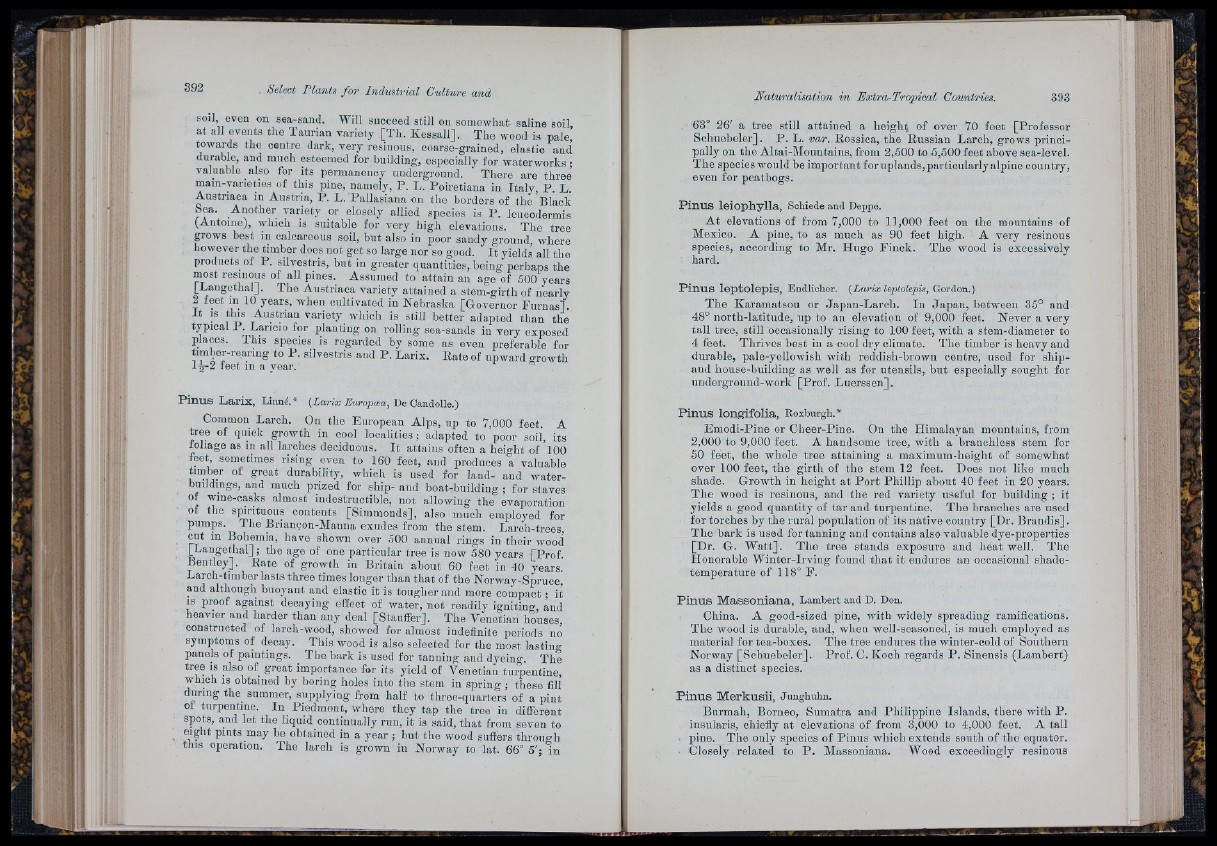
IA
soil, evou on sea-sand. Will succeed stiil on somewhat saline soil
at all events the Taurian variety [T h . Kessall]. The wood is pale,
towards the centre dark, very resinous, coarse-grained, elastic and
durable, and mucli esteemed for building, especially for waterworks •
valuable also for its permanency underground. There are three
mam-vaneties of this pine, namely, P . L. Poiretiana in Italy, P L
Austnaca in Austria, P. L. Pallasiaua on the borders of the Black
Sea. Another variety or closely allied species is P . ieucodermis
(Antoine), which is suitable for very high elevations. The tree
glows best in calcareous soil, but also in poor sandy ground, where
however the timber does not get so large nor so good. I t yields all the
products of P. silvestris, bnt in greater quantities, being perhaps the
most resinous of all pines. Assumed to attain an age of 500 years
[Langethal]. The Austriaoa variety attained a stem-girth of nearly
2 feet in 10 years, when cultivated in Nebraska [Governor Furnas].
I t is this Austrian variety wliich is still hotter adapted than the
typical P . Larieio for planting on rolling sea-sands ill very exposed
places. This species is regarded by some as even preferable for
timber-rearing to P. silvestris and P . Larix. Rate of upward growth
l i - 2 feet in a year.
P in u s L a rix , Linné.* ( la i lx Ftiropoea, De Candolle.)
Common Larch. On the European Alps, up to 7,000 feet A
free of quick growth in cool localities; adapted to poor soil’, its
foliage as iu all larches deciduous. I t attains often a height of 100
feet, sometimes rising even to 160 feet, and produces a valuable
timber of great durability, which is used for land- aud water-
bmldmgs, and much prized for ship- and boat-building ; for staves
of wine-casks almost indestructible, not allowing the evaporation
of the spirituous contents [Simmonds], also much employed for
pumps. The Briançon-Manna exudes from the stem. Larch-trees,
mt in Bohemia, have shown over 500 annual rings in their wood
Langethal] ; the age of one particular tree is now 580 years [Prof.
Bentley], Rate of growth in Britain about 60 feet in 40 years.
Larch-timber lasts three times longer than th a t of the Norway-Spruce,
and although buoyant and elastic it is tougher and more compact • it
IS proof against decaying effect of water, not readily igniting, and
heavier and harder than any deal [Stauffer]. The Venetian houses,
oonstrncted of laroli-wood, showed for almost indefinite periods no
symptoms of decay. This wood is also selected for the most lasting
panels of paintings. The bark is used for tanning and dyeing. The
tree is also of great importance for its yield of Venetian turpentine,
which is obtained by boring holes into the stem iu spring ; these fill
during the summer, supplying from half to three-quarters of a pint
ot turpentine. In Piedmont, where they tap the tree in different
spots, a,nd let the liquid^ continually run, it is said, th a t from seven to
eight pints may be obtained in a year ; but the wood suffers through
tins operation. The larch is grown in Norway to lat. 66“ 5'; iu
63° 26' a tree still attained a heighf of over 70 feet [Professor
Schuebeler]. P . L. var, Rossica, the Russian Larch, grows principally
on the Altai-Mountains, from 2,500 to 5,500 feet above sea-level.
'The species would be important for uplands, particularly alpine country,
even for peatbogs.
P in u s le io p h y lla , Schiede and Deppe.
A t elevations of from 7,000 to 11,000 feet ou the mountains of
Mexico. A pine, to as much as 90 feet high. A very resinous
species, according to Mr. lin g o Finck. The wood is excessively
hard.
P in u s le p to le p is , Endlicher, (Larix leptoUpis, Gordon.)
The Karamatsou or Japan-Laroh. In Japan, between 35° and
48° north-latitude, up to an elevation of 9,000 feet. Never a very
tall tree, still occasionally rising to 100 feet, with a stem-diameter to
4 feet. Thrives best in a cool dry climate. The timber is heavy and
durable, pale-yellowish with reddish-brown centre, used for ship-
anci house-building as well as for utensils, but especially sought for
underground-work [Prof. Luerssen].
P in u s lon,gifolia, Roxburgh.*
Emodi-Pine or Cheer-Pine. On the Himalayan mountains, from
2,000 to 9,000 feet. A handsome tree, with a branchless stem for
50 feet, the whole tree attaining a maximum-height of somewhat
over 100 feet, the girth of the stem 12 feet. Does not like much
shade. Growth in height a t P o rt Phillip about 40 feet in 20 years.
'The wood is resinous, and the red variety useful for building ; it
yields a good quantity of tar and turpentine. 'The branches are used
for torches by the rural population of its native country [Dr. Brandis].
The hark is used for tanning and contains also valuable dye-properties
[Dr. G. W a tt]. The tree stands exposure and lieat well. The
Honorable Winter-Irving found th a t it endures an occasional shade-
temperature of 118° F.
P in u s M a s so n ia n a , Lambert and D. Don.
China. A good-sized pine, with widely spreading ramifications.
The wood is durable, and, when well-seasoned, is much employed as
material for tea-boxes. 'The tree endures the winter-cold of Southern
Norway [Schuebeler]. Prof. C. Kooh regards P . Sinensis (Lambert)
as a distinct species.
P in u s M e rk u s ii, Jnnghuhn.
Burmah, Borneo, Sumatra and Philippine Islands, there with P.
insularis, chiefly at elevations of from 3,000 to 4,000 feet. A tall
pine. The only species of Pinus which extends south of the equator.
• Closely related to P . Massoniana. Wood exceedingly resinous